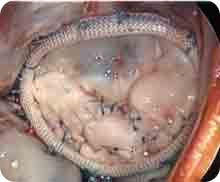Pulmonary Valve Repair Surgery
Written By: Adam Pick, Patient Advocate, Author & Website Founder
Page Last Updated: May 14, 2025
As shown in the anatomy of the heart, the pulmonary valve lies between the heart’s right ventricle and the pulmonary artery. As the right ventricle contracts during systole, the pulmonary valve opens.

This allows blood to flow through the pulmonary artery and into the lungs where blood is oxygenated. As the right ventricle relaxes, the three cusps of the pulmonary valve shut which prevents un-oxygenated blood from leaking backwards into the heart.
What is Pulmonary Valve Repair Surgery?
Pathologies that affect the pulmonary valve are, for the most part, congenital conditions although occasionally, they are caused by illnesses like rheumatic fever. The most common pulmonary valve pathology is one called pulmonary valve stenosis, a narrowing either of the valve itself, or the anatomical regions directly above or below the valve. Pulmonary valve stenosis is often linked to pulmonary valve regurgitation, a condition in which blood flows backwards into the heart, leading to an enlargement of the right ventricle.
Depending upon where the stenosis occurs, pulmonary valve stenosis can be repaired non-surgically through a procedure known as balloon valvuloplasty, or surgically during open heart surgery. In some instances, the pulmonary valve may be so diseased, replacement is indicated.
A significant proportion of candidates for pulmonary valve surgery are children. Children born with pulmonary valve stenosis may be asymptomatic at birth, but begin developing symptoms as growth spurts put demands on their hearts.
Balloon Valvuloplasty
Balloon valvuloplasty is a minimally invasive procedure in which a physician uses a technique called cardiac catheterization to thread a small tube with an uninflated balloon into a leg vein.
The physician then maneuvers the tube into the heart, using imaging technology to guide the tube’s progress, and slowly inflates the tube at the site of the stenosis. After the procedure, the balloon is removed.
Open Heart Surgery
In cases where the stenosis is not in the pulmonary valve itself but immediately above or below the valve, balloon valvuloplasty will not be effective. In these cases, open heart surgery is indicated. The cardiac surgeon will reshape the valve’s cusps to widen the valve’s opening. The patient will be placed on a cardio-pulmonary bypass machine while the operation takes place.
Frequently, surgical repair of the stenosis also involves placing a medical device called an annuloplasty ring around the pulmonary valve to prevent blood from leaking backwards into the right ventricle. Annuloplasty rings are made from a flexible plastic that allows them to maintain the shape and function of the valve without impeding the heartbeat.
Who Is a Candidate For Pulmonary Valve Repair?
Candidates for pulmonary valve repairs are individuals whose quality of life is severely impacted by the severity of their pulmonary valve disease. While congenital heart defects are not common, pulmonary valve stenosis accounts for 10 percent of all congenital heart defects.
The more severe the obstruction, the earlier the obstruction will be detected. Children represent a significant proportion of patients undergoing treatment for this condition. Newborns will present with a bluish color that doesn’t resolve when oxygen is given. Alternatively, physicians will detect the condition when they hear a loud murmur in the right ventricular region. Pulmonary stenosis is one of the classic malformations associated with Tetralogy of Fallot.
It is not uncommon for children with pulmonary valve disease to undergo multiple pulmonary valve procedures, as their growing bodies put additional demands on their hearts.
Many adults with mild pulmonary stenosis are only minimally symptomatic and the condition, if discovered, can be treated with medication. Adults who require pulmonary valve repair typically present with congestive heart failure symptoms, as the cardiac muscle is simply not strong enough to pump sufficient blood through the narrow opening.
You Might Also Like
To help you learn more about pulmonary valve repair, here is additional information and patient updates:




